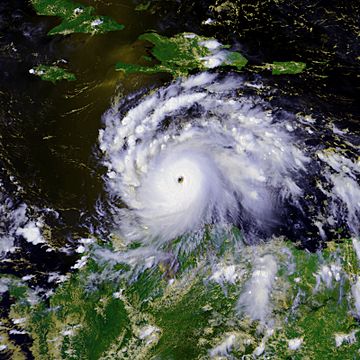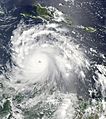Hurricane Felix facts for kids
| Category 5 major hurricane (SSHWS/NWS) | |

Hurricane Felix during rapid intensification.
|
|
| Formed | August 31, 2007 |
|---|---|
| Dissipated | September 5, 2007 |
| Highest winds | 1-minute sustained: 175 mph (280 km/h) |
| Lowest pressure | 929 mbar (hPa); 27.43 inHg |
| Fatalities | 130 direct, 3 indirect |
| Damage | $720 million (2007 USD) |
| Areas affected | Southern Windward Islands, ABC islands, Venezuela, Nicaragua, Honduras, El Salvador, Guatemala |
| Part of the 2007 Atlantic hurricane season | |
Hurricane Felix was a very powerful hurricane that hit parts of Central America in September 2007. It was one of the strongest storms of the 2007 Atlantic hurricane season. Felix reached Category 5 strength, which is the highest level for a hurricane, meaning it had incredibly fast winds of about 175 miles per hour (280 kilometers per hour).
Contents
What Was Hurricane Felix?
Hurricane Felix was a huge storm that formed in the Atlantic Ocean. It quickly grew stronger and became a hurricane, which is a type of storm with very strong winds and heavy rain. Felix was special because it reached Category 5, making it an extremely dangerous storm.
Felix's Journey
Felix started as a tropical wave on August 31, 2007, near the Windward Islands in the Caribbean Sea. It moved west and quickly gained power.
- On September 1, it became a hurricane.
- By September 2, Felix had turned into a Category 5 hurricane. This means its winds were strong enough to cause a lot of damage.
- Felix kept moving west, heading towards Central America.
Countries Affected
Hurricane Felix caused problems in several countries as it moved across the Caribbean Sea and into Central America.
- ABC islands: These islands (Aruba, Bonaire, and Curaçao) felt some of Felix's strong winds and rain, but they avoided the worst of the storm.
- Nicaragua: Felix made landfall, or hit the land, in northeastern Nicaragua as a Category 5 hurricane on September 4. This area, especially the Mosquito Coast, was hit very hard.
- Honduras: After hitting Nicaragua, Felix moved into Honduras, bringing heavy rains and strong winds.
- Guatemala and El Salvador: These countries also experienced some effects from the storm, mostly heavy rainfall.
The Impact of Felix
When Hurricane Felix hit, it caused a lot of destruction.
- Damage: The strong winds and heavy rains destroyed homes, buildings, and crops. Trees were knocked down, and power lines were broken, leaving many people without electricity.
- Flooding: The heavy rain caused widespread flooding, which made it hard for people to travel and for help to reach those who needed it.
- Fatalities: Sadly, many people lost their lives because of the storm. Most of these deaths happened in Nicaragua.
Remembering Felix
Because Hurricane Felix caused so much damage and loss of life, its name was "retired." This means that the name Felix will never be used again for another hurricane in the Atlantic Ocean. This is done for very destructive storms to remember their impact and to avoid confusion in the future.
Images for kids
-
Hurricane Felix rapidly intensifying south of Hispaniola on September 2
-
Hurricane Felix in the western Caribbean Sea, nearing Central America on September 3
-
Felix passing Aruba
-
Hurricane Felix after its landfall in Nicaragua on September 4
See also
 In Spanish: Huracán Félix para niños
In Spanish: Huracán Félix para niños





